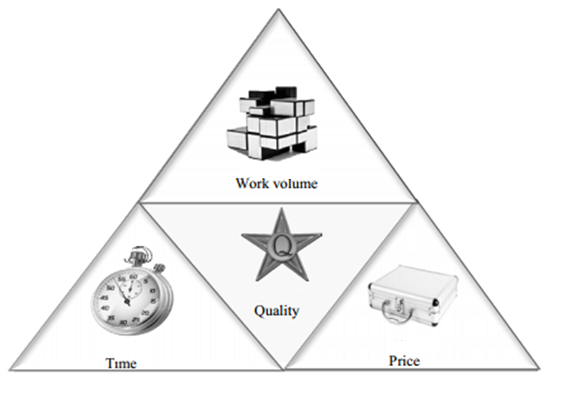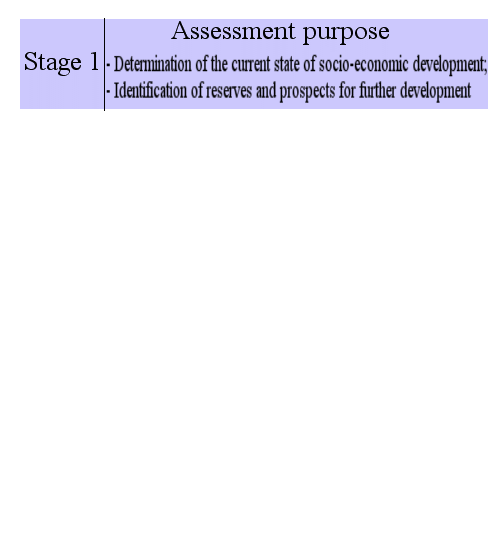Abstract
Theoretical basis for the development of a project for the socio-economic development of small and medium-sized enterprises of the Donetsk People's Republic (DPR)
Content
- Introduction
- 1. Relevance
- 2. Purpose and objectives
- 3. Analysis of recent research and publications
- 4. The theoretical basis of the project approach in the strategic management of a modern enterprise
- 5. The concept and assessment of the level of socio-economic development of the enterprise
- 6. The concept and significance of the development of small business in modern conditions
- 6.1 The importance of small business development in modern conditions
- 6.2 The importance of small business development in the conditions of the DPR
- Conclusion
- References
Introduction
The effectiveness of managing the socio-economic development of the enterprise ensures the competitiveness and leadership of business entities in the modern world. One of the directions of increasing management efficiency is the use of the project approach in the enterprise. The project approach allows the organization to achieve a balance between the cost of implementation and the main parameters of the project: the time of the project and the amount of work performed.
The project management approach has moved from the field of heavy industry and construction to other areas. If earlier, when reproducing the word project
, an investment project was often meant, now project management has moved into the category of methodology in the strategic management of an enterprise. Thanks to this approach, an organization, being an open economic system that is influenced by a large number of external factors, is still able to adequately respond to these disturbances (new opportunities), which demonstrates a qualitatively new level of its development.
1. Relevance
Currently, there is a tendency to move from traditional management approaches in strategic management to a project approach. There are a number of reasons for this. Firstly, project activity allows solving managerial tasks more efficiently than traditional and operational management tools. Secondly, it is the project approach that allows you to combine the functional units of the organization into a team to achieve the goals and indicators of the strategy.
Despite the difficult economic and political situation in the DPR, enterprises continue to function, including small enterprises that are the engine of the DPR economy. For their successful functioning, it is necessary to have strategic management, which, according to modern trends, should be implemented using the project approach. Enterprises in the face of modern challenges should strive to obtain not only economic, but also social results. Small enterprises, due to their small resources, should be especially careful in their development and in the competition, therefore strategic management with an orientation towards a comprehensive socio-economic result is especially relevant for them. The relevance is further emphasized by the lack of similar developments for small businesses.
2. Purpose and objectives
The aim of the study is to generalize the theoretical principles of the project approach in strategic management, the socio-economic development of a small enterprise and identify the features and problems of the functioning of the small business of the DPR food industry.
To achieve this goal, we need to solve the following tasks:
- Consider the theoretical foundations of the project approach in strategic management.
- Describe the essence of the socio-economic development of the enterprise.
- To reveal the significance and problems of the development of small business in modern market relations and in the conditions of the DPR.
The object of the research is the development processes of the project of socio-economic development of a small food industry enterprise.
The subject of the study is the theoretical foundations and methodological provisions of the development of the project of socio-economic development of a small food industry enterprise.
3. Analysis of recent research and publications
The issues of the project approach in the strategic management of the enterprise were studied by such scientists as: N.V. Nikolaevna, A.A. Gribin, K.S. Sapiuly, E.A. Fedorova, R.Y. Boldyreva. The concept of socio-economic development of the enterprise, the measurement of its level in their work was considered by E.V. Raevneva, T.L. Ivanova, T.B. Nadtoka, A.G. Vinogradov. The following scientists were engaged in questions of the importance of small business development in modern conditions: Z.O. Tekeeva, S.A. Kurbanov, D.D. Saidulaev et al. These scientists clarified the essence and substantiated the method of measuring the level of socio-economic development, however, the development problems and the specifics of a small enterprise in the conditions of the DPR were not taken into account, which led to the relevance of this study.
4. The theoretical basis of the project approach in the strategic management of a modern enterprise
The following are used as the main strategic management approaches at the enterprise: process, system, situational and project approaches.
With the process approach, all management functions are considered as interrelated. The strategic management process is a chain of continuous interconnected actions for strategic planning, organization (implementation of the strategy), accounting and control, regulation. [1]. Achieving the goals of the enterprise with a process approach depends on the coherence of the work of the whole team, and not its individual representatives.
A systematic approach to management is a methodology for the study of objects as systems. The system consists of 2 components: the external environment (communication with the external environment) and the internal structure (components that ensure the impact of the control subject on the object, achieving goals) [1].
The situational approach focuses on the fact that the suitability of various management methods is determined by the specific situation. In other words, changing conditions actualize different tools, the use of which is relevant only under specific conditions – this is the essence of the situational approach in the strategic management of a modern enterprise [2].
Recently, however, a relatively young and rather specific project approach to traditional management has been gaining popularity. This approach, like all previous ones, is aimed at the successful achievement of the goals and objectives of the enterprise, but at the same time there are limitations, the so-called iron triangle [3] (fig. 1).

Figure 1 – Iron triangle project limitations
As can be seen from fig. 1, all projects have a specific end date, budget and scope of work. Quality, the fourth element of the design triangle, is in the center, and changes made to either side of the triangle always affect quality. The main objective of project management is to achieve the optimal balance between the cost of the project, the time of the project and the volume of work performed, without compromising the quality of the product at the exit [4].
As for the role of the project approach in the strategic management of the enterprise, this is an effective tool for planning, operationalization and monitoring the achievement of strategic goals (fig. 2).

Figure 2 – Typical scheme of operationalization of company strategy
(animation: 9 frames, 5 cycles of repetition, 14.1 kilobytes)
Based on fig. 2, the project approach in strategic management is implemented through the formation of the goals that a particular enterprise faces, the definition of a strategy that will meet the intended goals, the formation of project portfolios and programs, the implementation of projects through the sequential execution of a number of operations and / or work. Thus, each work that a specific employee performs is tied to the achievement of the strategic goals of the organization.
5. The concept and assessment of the level of socio-economic development of the enterprise
Enterprises actively interact with the external environment, and, therefore, relate to open systems. Under the influence of the environment, enterprises undergo constant changes, which are called nothing more than development, that is, directed irreversible qualitative changes.
Often the concept of development is identified with the concept of growth, which is wrong, because, firstly, development is a qualitative change in the composition, structure and relations of something, while growth expresses a quantitative change in composition and relationships; secondly, development can go both along the line of progress, and along the line of regression [5].
In order to more accurately operate with the concept of development
, we give a description of this concept, which is given by various authors (table 1).
Table 1 – Definition of development
| Author (source) | Definition |
| Ozhegov S.I. Explanatory dictionary of the Russian language | 1) Development is the process of bringing to a certain degree spiritual, mental maturity, cultural awareness to a certain degree of strength, power, and perfection; 2) Development is a process of regular change, the transition of the initial state to another, more perfect one; transition from the old qualitative state to the new, from simple to complex, from lower to higher [6]. |
| Loguntsev E. | 1) Development is a fundamental property of matter, expressed differently in various systems (physical, mechanical, biological, social); 2) Development is an irreversible, directed, regular change, characterized by the transformation of quality, the transition to new levels of organization [7]. |
| Yarullina G.R. | Development is a process of expedient continuous irreversible directed regular changes in time, characterized by a transition to a qualitatively new, more perfect state [8]. |
Based on the table. 1, it can be determined that development is a naturally necessary process leading to changes, as a result of which the object passes into a qualitatively new state and acquires new properties.
The operational efficiency of any enterprise is measured by indicators characterizing the organization’s activities from an economic point of view, as well as social, since focusing only on the production component can lead to problems regarding the social component of the enterprise (adverse working conditions, low wages, etc.), which subsequently also reduce the effectiveness of its functioning. Therefore, when it comes to the development of an enterprise, first of all, this refers to socio-economic development.
Analysis and assessment of the level of socio-economic development of the enterprise includes 5 stages (Fig. 3).

Figure 3 – The generalized scheme of analysis and evaluation of socio-economic development of the enterprise [9]
(animation: 9 frames, 5 cycles of repetition, 39.2 kilobytes)
The task of the first stage is determining the appropriateness of the proposed assessment and the formation of target settings. The second stage is the collection and preparation of baseline data to ensure a reliable assessment of the level of socio-economic development of the enterprise. The fourth stage is directly assessing the level of socio-economic development of the enterprise. At the last stage, conclusions and suggestions are formed to solve the tasks and problems.
As a rule, an assessment of the level of socio-economic development of an enterprise, which is used by various business entities, is as close as possible to the Global Initiative
system and has the form presented in table 2.
Table 2 – System for assessing the level of socio-economic development of enterprises
| Economic indicators | Social indicators |
| 1. Performance indicators | 1. Labor Organization Indicators |
| 1.1 Net income (revenue) from the sale of products (goods, works, services) | 1.1 Number of employees |
| 1.2 Net income (loss) | 1.2 Staff turnover rate |
| 1.3 Payments to capital providers | 1.3 Average employee salary |
| 1.4 Financial independence | 1.4 Coverage of employees by collective agreement |
| 1.5 Labor productivity | 2. Occupational Health Indicators |
| 1.6 Return on total capital | 2.1 Injury rate at work |
| 1.7 Return on equity | 2.2 Occupational Disease Level |
| 1.8 Return on sales | 2.3 Labor protection expenses |
| 1.9 Net production margin | 3. Employment Education Indicators |
| 1.10 Product Quality Assurance | 3.1 Personnel training |
| 2. Indicators of innovation and investment development | 3.2 Further training for employees |
| 2.1 Mastering new types of products | 3.3 Education spending level |
| 2.2 Introduction of new technological processes | 4. Environmental performance |
| 2.3 Fixed investment | 4.1 Waste volume |
| 2.4 Community investment | 4.2 The share of raw materials used again |
| 2.5 Investments in environmental facilities | 4.3 Recycled Water Volume |
| 3. Indicators of business activity of the enterprise | 5. Indicators of interaction of the enterprise with the public |
| 3.1 Asset turnover ratio | 5.1 Interaction with authorities regarding the socio-economic development of the territory |
| 3.2 Accounts receivable turnover ratio | 5.2 Interaction with non-profit organizations regarding the solution of socially significant issues |
| 3.3 Accounts payable turnover ratio | 5.3 Participation in the formation of public policy |
| 3.4 Inventory turnover ratio | |
| 3.5 Fixed assets turnover ratio (capital productivity) |
The indicators presented in table. 2 are generalized and may vary depending on the affiliation of the enterprise to a particular industry, as well as to small, medium or large business.
6 The concept and significance of the development of small business in modern conditions
6.1 The importance of small business development in modern conditions
The functioning of small business is an integral part of market relations. Moreover, it should be argued that small business or small business and a market economy are interdependent factors. On the one hand, small business is called upon to be one of the most significant factors of influence on the development of the national economy of any country. On the other hand, the market management mechanism promotes the formation of entrepreneurial activity. However, it is small business, and not large, as it is mistakenly believed to be, a mechanism that provides for the development of the country's economy to a greater extent, contributes to the development of fair competition, and, what is important, is an integral part for maintaining and developing large business.
Thus, an indisputable fact testifying to the importance of small business is that the economies of many developed countries are based on small businesses, the share of which in the gross domestic product of some countries is 50% or more. The share of small business in the total number of enterprises reaches 90%, and the share in the total amount of employment is approximately 70% in developed countries. Since statistics, as a rule, reflect the dynamics of small business in combination with medium, the dynamics of the development of small and medium enterprises in developed and developing countries will be considered below (table 3).
Table 3 – Dynamics of SME development and its contribution to the national economy of individual countries [10],[11]
| USA | |
|
|
||||
| Japan | |
|
|
|
|
||
| The EU | |
|
|
|
|||
| Germany | |
|
|
|
|
||
| Italy | |
|
|
|
|
||
| United Kingdom | |
|
|
|
|
||
| France | |
|
|
|
|
||
| China | |
|
|
|
|
||
| Russia | |
|
|
|
|
||
| Belarus | |
|
|
|
|
Ukraine | |
*,** –inaccurate and missing data, respectively
The importance of small business for the country as a whole in modern market conditions lies in the implementation by the latter of a number of important functions, such as:
1) social function (alternative to social dependency, involvement of certain groups of the population in labor activity, etc.);
2) economic function (reducing unemployment, developing fair competition; securing revenue to the state budget, etc.);
3) institutional function (the formation of new market institutions, etc.);
4) political function (the basis for the formation of the middle class);
5) environmental function (disposal of large-scale waste).
6.2 The importance of small business development in the conditions of the DPR
Before deciding on the importance of small business in the conditions of the DPR, it is necessary to understand what criteria constitute small businesses.
In the Donetsk People’s Republic, currently all business entities operating on the territory of the DPR are classified in accordance with republican standards developed taking into account the Commercial Code of Ukraine, since a similar document is currently not available in the Republic. That is, small businesses in the Donetsk People’s Republic are individuals registered in the manner prescribed by law as individual entrepreneurs and legal entities whose average number of employees for the reporting period (calendar year) does not exceed 50 people and annual income from any activity does not exceed the amount equivalent to 2 million euros.
However, in the DPR, in addition to the general taxation system, there is a simplified taxation system that can also be applied to small businesses. This is Group I, which includes enterprises with a total number of employees of up to 10 people and with an annual gross income of up to 1.5 million rubles. (simplified tax rate – 2.5% of the monthly income amount), group II, which includes enterprises with no restrictions on the number of employees, but with gross income up to 60 million rubles (the simplified tax rate is 6%). For comparison, the tax rate for the general system is 20% of net profit and 1.5% of turnover.
There is also group III, however, this simplified tax group can be applied only to coal mining enterprises, and, accordingly, is not applicable to small businesses, therefore this group does not cause much interest in the context of the topic of this work and will not be considered in more detail. Thus, 2 groups of simplified tax in the DPR can be applied to small businesses.
As for the importance of the development of small business in the conditions of the DPR, for the Donetsk People's Republic, the development of small business can be the solution to the following problems:
1) the formation of competitive, civilized market relations that contribute to better meeting the needs of the population and society;
2) expanding the assortment and improving the quality of goods, works, services (in an effort to satisfy consumer demands, small business helps to improve the quality of goods, works, services and service culture);
3) bringing production of goods and services closer to specific consumers;
4) promoting more efficient use of people's creative abilities, revealing their talents, the development of various types of crafts, crafts;
5) involvement in the work of certain groups of the population for which large-scale production imposes certain restrictions (housewives, retirees, disabled people, students), etc.
In principle, the development of small business in the DPR is just as important as for countries not burdened with complex economic and political relations. But if other countries with market economies have the same opportunities, both for creating a small business and creating a large one, then the existing economic and political relations in the Republic do not allow creating new large enterprises at the moment, therefore it is small business that is currently the engine of development of the state economy.
Conclusion
The project approach is one of the main approaches in the strategic management of a modern enterprise. Thanks to this approach, the enterprise achieves the optimal balance between the cost of the project, the time of the project and the volume of work performed, without compromising the quality of the product at the output. A project in strategic management is the transformation of a strategy into step-by-step actions or activities that are assigned to each employee.
To maintain the competitiveness of the enterprise, the company needs to monitor the level of socio-economic development through economic (indicators of performance, indicators of innovation and investment development, indicators of business activity of the enterprise) and social (indicators of labor organization, indicators of labor protection, indicators of employee education, environmental indicators, indicators interaction of the enterprise with the public) indicators.
The functioning of small business is an integral part of market relations. In developed countries, the share of small business in gross domestic product is 50% or more. The share of small business in the total number of enterprises reaches 90%, and the share in the total amount of employment is approximately 70%. The development of small business in the DPR is also important, since it is small business in the prevailing economic and political conditions that can become the basis of social restructuring of society.
Work on writing a master's thesis on selected topics is still underway. This essay presents only preliminary results of one of its parts.
References
- Федорова, Е. А. Модернизация инструментов стратегического планирования на основе проектного менеджмента / Е. А. Федорова, Р. Ю. Болдырева // Известия ТулГУ. Экономические и юридические науки. – 2013. – №1-2. – Режим доступа: https://cyberleninka.ru/....
- Ермолова, М. М. Проектный подход к стратегическому планированию деятельности организации [Электронный ресурс]. – Режим доступа: http://www.vectoreconomy.ru/... – Загл. с экрана.
- Осипов Д. В. Управление проектами: Учебное пособие для магистров направления
Менеджмент
. – М.: РУТ (МИИТ), 2017. – 170 с. - Карим, М. С. Проектное управление как инструмент реализации стратегии, реалии и перспективы применения в нефтегазодобывающих предприятиях Республики Казахстан / М. С. Карим // Вестник ВГУИТ. – 2017. – №1 (79). – С. 332-337.
- Лебедев, Д. С. Институциональная трансформация социально-экономических систем: теория, методология анализа, практика применения во внешней торговле России : монография / Д. С. Лебедев. – Москва : Проспект, 2016. – 190 с.
- Ожегов, С. И. Толковый словарь русского языка / С. И. Ожегов; под ред. Л. И. Скворцова. – 28-е изд., перераб. – М.: Мир и Образование, 2015. – 1376 с.
- Логунцев, Е. Концепция устойчивого развития с позиций междисциплинароного подхода / Е. Логунцев // Городское управление. – 2000. – № 11. – С. 24-32.
- Яруллина, Г. Р. Управление устойчивым экономическим развитием предприятий промышленного комплекса: теория и методология : Автореф. дис. …д-ра. экон. наук. – Казань, 2011. – 46 с.
- Калинеску Т. В., Недобега Е. А. Анализ и оценка уровня социально-экономического развития предприятия / Т. В. Калинеску, Е. А. Недобега // Бизнес Информ. – 2011. – №2(2). – С. 117-119.
- Сяомэй, Л. Малый и средний бизнес в условиях глобализации мировой экономики / Л. Сяомэй // Вестник ГГТУ им. П. О. Сухого. – 2014. – № 2. – С.89-95.
- Сыч, О. А. Современное состояние и условия кредитования малого и среднего бизнеса в Украине / О. А Сыч, И. И. Волос // Молодой ученый. – 2018. – № 2 (54). – С.421-424.
